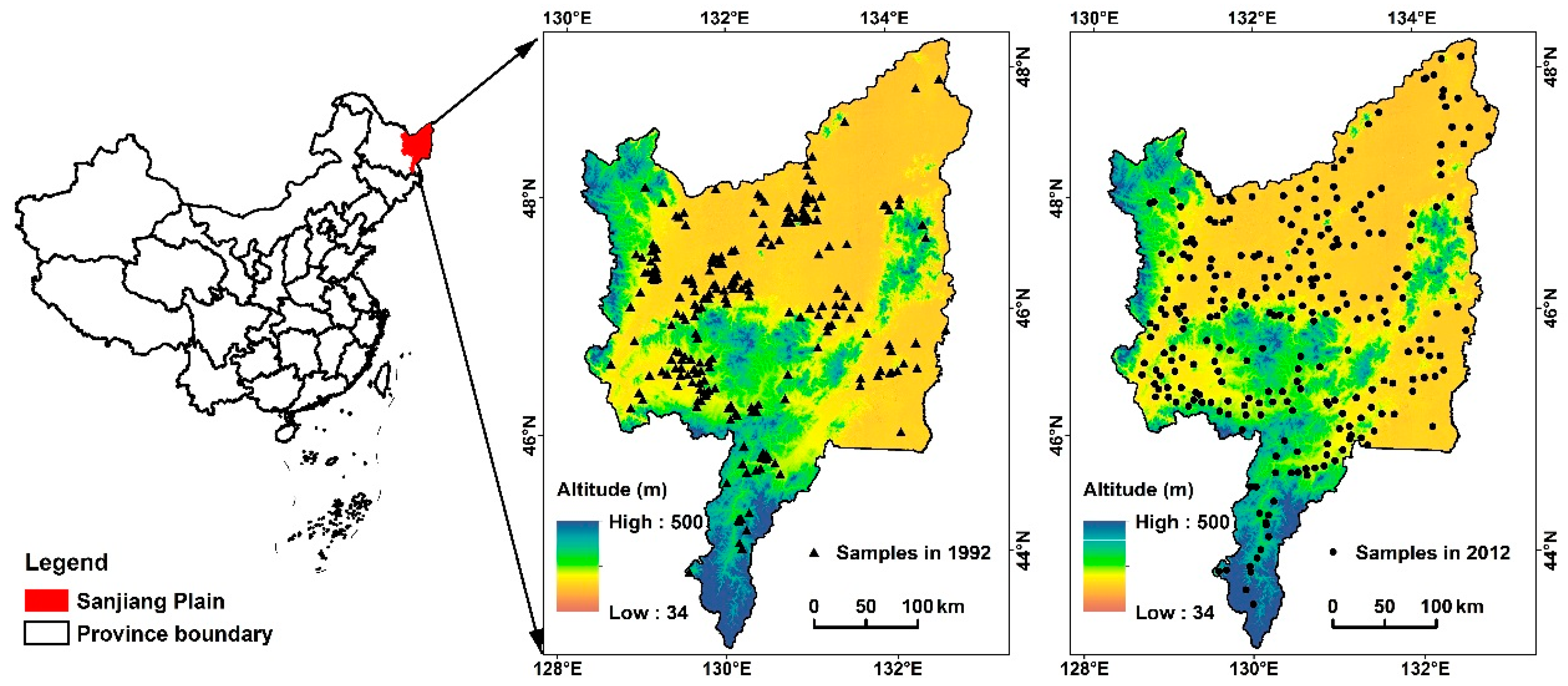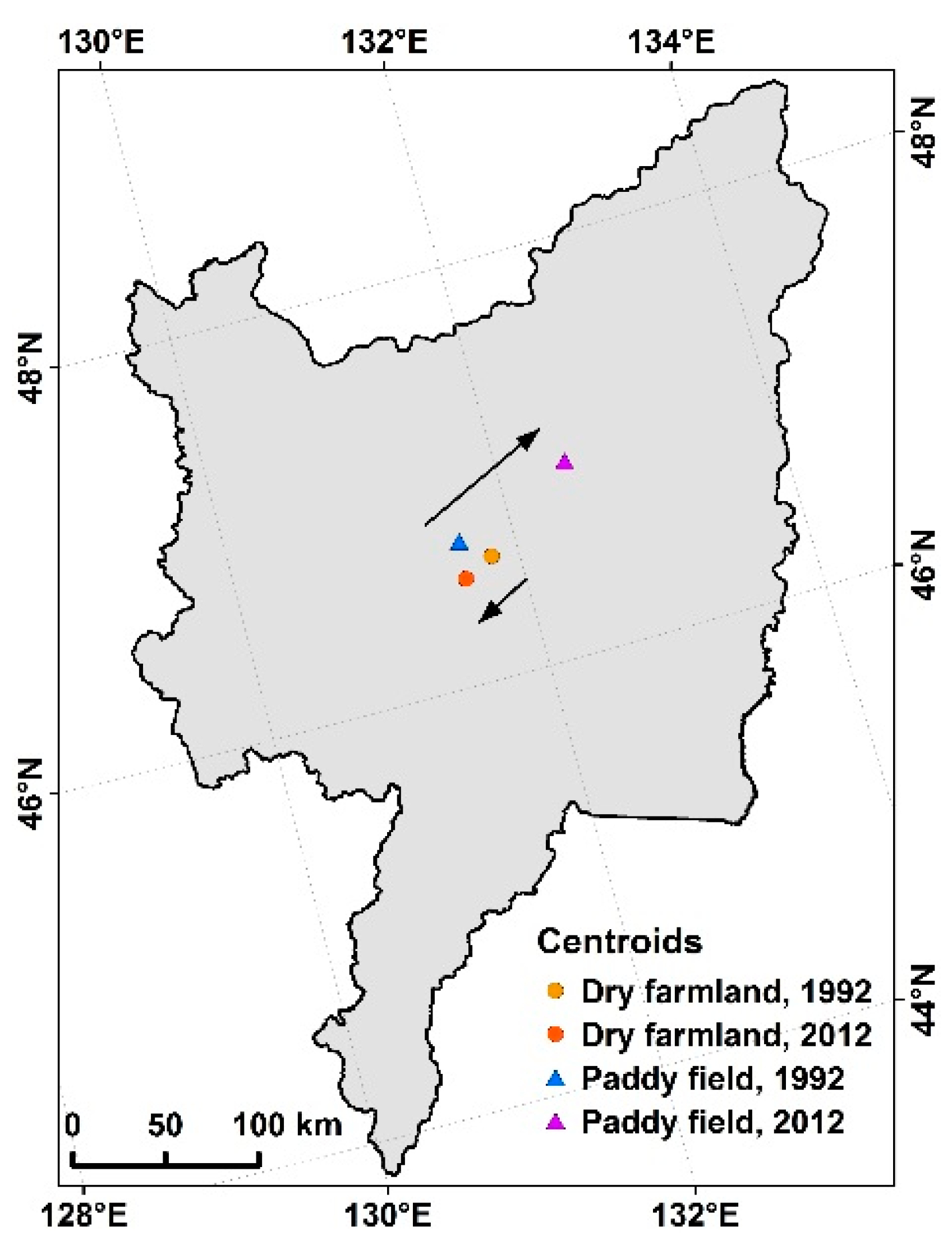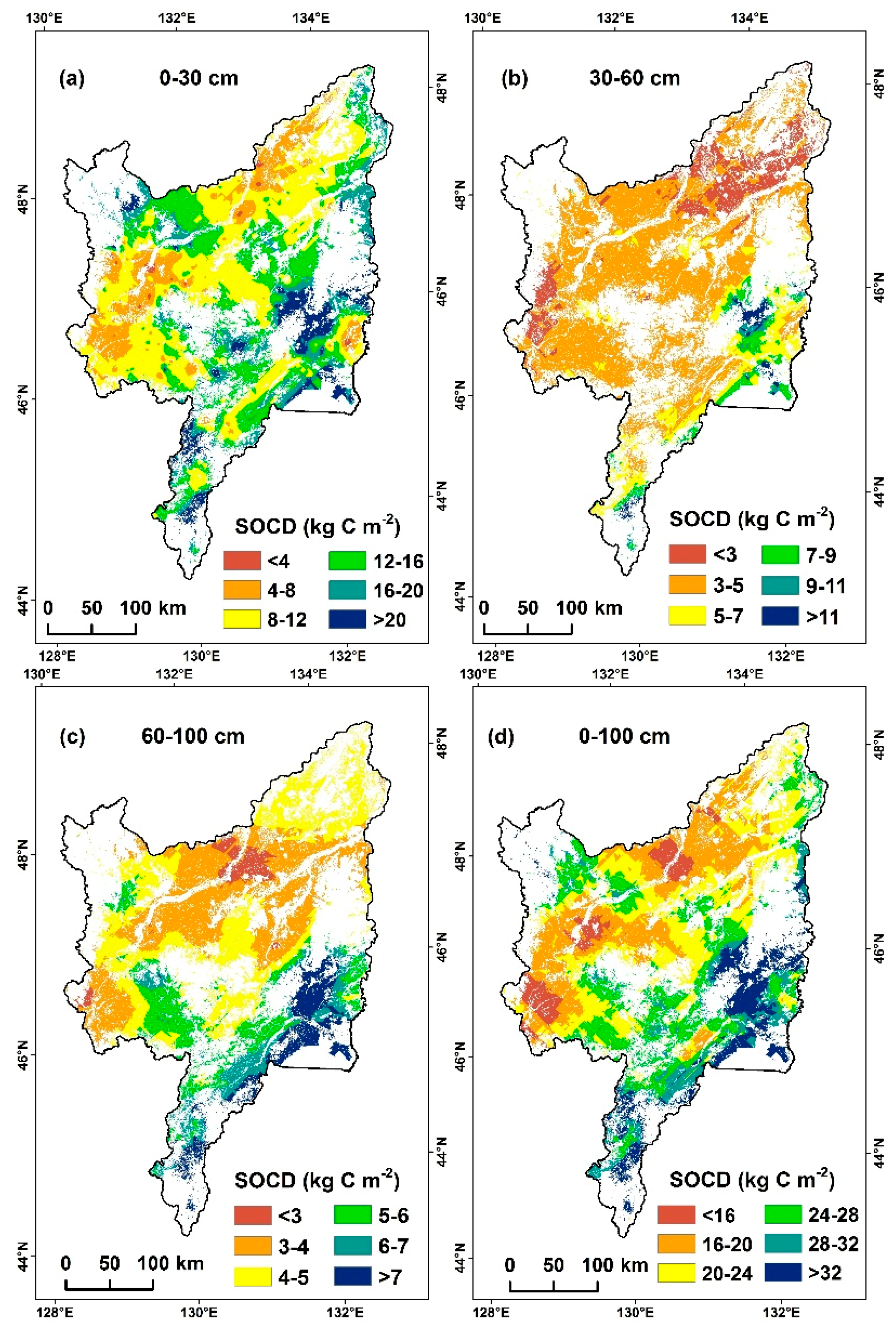Spatial Expansion and Soil Organic Carbon Storage Changes of Croplands in the Sanjiang Plain, China
Abstract
:1. Introduction
2. Materials and Methods
2.1. Description of Study Area
2.2. Object-Oriented Classification and Cropland Dynamics
2.2.1. Remote Sensing Data
2.2.2. Object-Oriented Classification
2.2.3. Calculation of the Area-Weighted Center
2.3. Soil Profile Data
2.4. Geostatistical Analysis
2.4.1. Geostatistical Analysis Method
2.4.2. Geostatistical Analysis of SOCD
3. Results
3.1. Cropland Changes
3.2. Descriptive Statistics for Soil Bulk Density (BD)
3.3. Spatio-Temporal Dynamics of SOCD
3.4. Change of SOC Storage
4. Discussion
4.1. Cropland Expansion and Conversion from Dry Farmlands to Paddy Fields
4.2. SOCD Dynamics during 1992–2012
4.2.1. SOCD Estimates
4.2.2. SOCD Decrease
4.2.3. Differences in SOCD Dynamics between Paddy Fields and Dry Farmlands
4.3. SOC Storage Changes
5. Conclusions
Acknowledgments
Author Contributions
Conflicts of Interest
References
- Johnson, D.W.; Todd, D.E.; Trettin, C.F.; Sedinger, J.S. Soil carbon and nitrogen changes in forests of walker branch watershed, 1972 to 2004. Soil Sci. Soc. Am. J. 2007, 71, 1639–1646. [Google Scholar] [CrossRef]
- Yang, Y.H.; Fang, J.Y.; Ma, W.H.; Smith, P.; Mohammat, A.; Wang, S.P.; Wang, W. Soil carbon stock and its changes in northern China’s grasslands from 1980s to 2000s. Glob. Chang. Biol. 2010, 16, 3036–3047. [Google Scholar] [CrossRef]
- Davidson, E.A.; Janssens, I.A. Temperature sensitivity of soil carbon decomposition and feedbacks to climate change. Nature 2006, 440, 165–173. [Google Scholar] [CrossRef] [PubMed]
- Mao, D.H.; Wang, Z.M.; Li, L.; Miao, Z.H.; Ma, W.H.; Song, C.C.; Ren, C.Y.; Jia, M.M. Soil organic carbon in the Sanjiang Plain of China: Storage, distribution and controlling factors. Biogeosciences 2015, 12, 1635–1645. [Google Scholar] [CrossRef]
- Trumbore, S.E.; Czimczik, C.I. Geology. An uncertain future for soil carbon. Science 2008, 321, 1455–1456. [Google Scholar] [CrossRef] [PubMed]
- Lal, R. Soil carbon sequestration impacts on global climate change and food security. Science 2004, 304, 1623–1627. [Google Scholar] [CrossRef] [PubMed]
- Heikkinen, J.; Ketoja, E.; Nuutinen, V.; Regina, K. Declining trend of carbon in Finnish cropland soils in 1974–2009. Glob. Chang. Biol. 2013, 19, 1456–1469. [Google Scholar] [CrossRef] [PubMed]
- Mao, D.H.; Wang, Z.M.; Wu, C.S.; Zhang, C.H.; Ren, C.Y. Topsoil carbon stock dynamics in the Songnen Plain of Northeast China from 1980 to 2010. Fresenius Environ. Bull. 2014, 23, 531–539. [Google Scholar]
- Wu, B.F.; Yuan, Q.Z.; Yan, C.Z.; Wang, Z.M.; Yu, X.F.; Li, A.N.; Ma, R.H.; Huang, J.L.; Chen, J.S.; Chang, C.; et al. Land cover changes of China from 2000 to 2010. Quat. Sci. 2014, 34, 723–731. [Google Scholar]
- Qin, Z.C.; Huang, Y.; Zhuang, Q.L. Soil organic carbon sequestration potential of cropland in China. Glob. Biogeochem. Cycles 2013, 27, 711–722. [Google Scholar] [CrossRef]
- Lal, R. Soil carbon sequestration in China through agricultural intensification, and restoration of degraded and desertified ecosystems. Land Degrad. Dev. 2002, 13, 469–478. [Google Scholar] [CrossRef]
- Jobbagy, E.G.; Jackson, R.B. The vertical distribution of soil organic carbon and its relation to climate and vegetation. Ecol. Appl. 2000, 10, 423–436. [Google Scholar] [CrossRef]
- He, C.F.; Wang, S.Q.; Xu, J.; Zhou, C.H. Using remote sensing to estimate the change of carbon storage: A case study in the estuary of Yellow River delta. Int. J. Remote Sens. 2002, 23, 1565–1580. [Google Scholar] [CrossRef]
- Yu, J.; Wang, Y.; Li, Y.; Dong, H.; Zhou, D.; Han, G.; Wu, H.; Wang, G.; Mao, P.; Gao, Y. Soil organic carbon storage changes in coastal wetlands of the modern Yellow River Delta from 2000 to 2009. Biogeosciences 2012, 9, 2325–2331. [Google Scholar] [CrossRef]
- De Moraes, J.F.L.; Seyler, F.; Cerri, C.C.; Volkoff, B. Land cover mapping and carbon pools estimates in Rondonia, Brazil. Int. J. Remote Sens. 1998, 19, 921–934. [Google Scholar] [CrossRef]
- Wang, S.Q.; Tian, H.Q.; Liu, J.Y.; Zhuang, D.F.; Zhang, S.W.; Hu, W.Y. Characterization of changes in land cover and carbon storage in Northeastern China: An analysis based on Landsat TM data. Sci. China Life Sci. 2002, 45, 40–47. [Google Scholar]
- Zhang, Y.; Linlin, X.; Weining, X. Analyzing spatial patterns of urban carbon metabolism: A case study in Beijing, China. Landsc. Urban Plan. 2014, 130, 184–200. [Google Scholar] [CrossRef]
- Pascucci, S.; Casa, R.; Belviso, C.; Palombo, A.; Pignatti, S.; Castaldi, F. Estimation of soil organic carbon from airborne hyperspectral thermal infrared data: A case study. Eur. J. Soil Sci. 2014, 65, 865–875. [Google Scholar] [CrossRef]
- Tiwari, S.K.; Saha, S.K.; Kumar, S. Prediction modeling and mapping of soil carbon content using artificial neural network, hyperspectral satellite data and field spectroscopy. Adv. Remote Sens. 2015, 4, 63–72. [Google Scholar] [CrossRef]
- Ferraz, A.; Saatchi, S.; Mallet, C.; Jacquemoud, S.; Gonçalves, G.; Silva, C.; Soares, P.; Tomé, M.; Pereira, L. Airborne Lidar Estimation of Aboveground Forest Biomass in the Absence of Field Inventory. Remote Sens. 2016, 8, 653. [Google Scholar] [CrossRef]
- Kumar, S. Soil organic carbon mapping at field and regional scales using GIS and remote sensing applications. Adv. Crop Sci. Technol. 2013. [Google Scholar] [CrossRef]
- Wang, Z.M.; Mao, D.H.; Li, L.; Jia, M.M.; Dong, Z.Y.; Miao, Z.H.; Ren, C.Y.; Song, C.C. Quantifying changes in multiple ecosystem services during 1992–2012 in the Sanjiang Plain of China. Sci. Total Environ. 2015, 514, 119–130. [Google Scholar] [CrossRef] [PubMed]
- Man, W.D.; Wang, Z.M.; Liu, M.Y.; Lu, C.Y.; Jia, M.M.; Mao, D.H.; Ren, C.Y. Spatio-temporal dynamics analysis of cropland in Northeast China during 1990–2013 based on remote sensing. Trans. Chin. Soc. Agric. Eng. 2016, 32, 1–10. [Google Scholar]
- Ke, Y.H.; Quackenbush, L.J.; Im, J. Synergistic use of QuickBird multispectral imagery and LIDAR data for object-based forest species classification. Remote Sens. Environ. 2010, 114, 1141–1154. [Google Scholar] [CrossRef]
- Jia, M.M.; Wang, Z.M.; Li, L.; Song, K.S.; Ren, C.Y.; Liu, B.; Mao, D.H. Mapping China’s mangroves based on an object-oriented classification of Landsat imagery. Wetlands 2014, 34, 277–283. [Google Scholar] [CrossRef]
- Mui, A.; He, Y.H.; Weng, Q.H. An object-based approach to delineate wetlands across landscapes of varied disturbance with high spatial resolution satellite imagery. ISPRS J. Photogramm. Remote Sens. 2015, 109, 30–46. [Google Scholar] [CrossRef]
- Aguirre-Gutiérrez, J.; Seijmonsbergen, A.C.; Duivenvoorden, J.F. Optimizing land cover classification accuracy for change detection, a combined pixel-based and object-based approach in a mountainous area in Mexico. Appl. Geogr. 2012, 34, 29–37. [Google Scholar] [CrossRef]
- Ehman, J.L.; Fan, W.H.; Randolph, J.C.; Southworth, J.; Welch, N.T. An integrated GIS and modeling approach for assessing the transient response of forests of the southern Great Lakes region to a doubled CO2 climate. For. Ecol. Manag. 2002, 155, 237–255. [Google Scholar] [CrossRef]
- Jia, M.M.; Wang, Z.M.; Zhang, Y.Z.; Ren, C.Y.; Song, K.S. Landsat-Based Estimation of Mangrove Forest Loss and Restoration in Guangxi Province, China, Influenced by Human and Natural Factors. IEEE J. Sel. Top. Appl. Earth Obs. Remote Sens. 2015, 8, 311–323. [Google Scholar] [CrossRef]
- Miao, Z.H.; Wang, Z.M.; Song, K.S.; Zhang, C.H.; Ren, C.Y. Spatial and temporal variability of Soil organic carbon in the Corn Belt of Northeastern China, 1980s–2005: A case study in four counties. Commun. Soil Sci. Plant Anal. 2014, 45, 163–176. [Google Scholar] [CrossRef]
- Mann, L.K. Changes in soil carbon storage after cultivation. Soil Sci. 1986, 142, 279–288. [Google Scholar] [CrossRef]
- McGrath, D.; Zhang, C.S. Spatial distribution of soil organic carbon concentrations in grassland of Ireland. Appl. Geochem. 2003, 18, 1629–1639. [Google Scholar] [CrossRef]
- Wang, Z.M.; Zhang, B.; Song, K.S.; Liu, D.W.; Ren, C.Y. Spatial Variability of Soil Organic Carbon Under Maize Monoculture in the Song-Nen Plain, Northeast China. Pedosphere 2010, 20, 80–89. [Google Scholar] [CrossRef]
- Webster, R.; Oliver, M.A. Geostatistics for Environmental Scientists, 2nd ed.; John Wiley & Sons: Chichester, UK, 2007. [Google Scholar]
- Hu, K.; Li, H.; Li, B.; Huang, Y. Spatial and temporal patterns of soil organic matter in the urban–rural transition zone of Beijing. Geoderma 2007, 141, 302–310. [Google Scholar] [CrossRef]
- Zhao, B.; Li, Z.; Li, P.; Xu, G.; Gao, H.; Cheng, Y.; Chang, E.; Yuan, S.; Zhang, Y.; Feng, Z. Spatial distribution of soil organic carbon and its influencing factors under the condition of ecological construction in a hilly-gully watershed of the Loess Plateau, China. Geoderma 2017, 296, 10–17. [Google Scholar] [CrossRef]
- Wang, Z.M.; Song, K.S.; Liu, D.W.; Zhang, B.; Zhang, S.Q.; Li, F.; Ren, C.Y.; Jin, C.; Yang, T.; Zhang, C.H. Process of Land Conversion from Marsh into Cropland in the Sanjiang Plain during 1954–2005. Wetl. Sci. 2009, 7, 208–217. [Google Scholar]
- Gao, J.; Liu, Y.S. Climate warming and land use change in Heilongjiang Province, Northeast China. Appl. Geogr. 2011, 31, 476–482. [Google Scholar] [CrossRef]
- Li, H.W.; Tian, Z.J.; Yang, W.; Li, X. Analysis of spatial distribution of agricultural meteorological conditions in the Sanjiang Plain during nearly 50 years. J. Anhui Agric. Sci. 2013, 41, 4493–4496. [Google Scholar]
- Holmes, K.W.; Chadwick, O.A.; Kyriakidis, P.C.; de Filho, E.P.S.; Soares, J.V.; Roberts, D.A. Large-area spatially explicit estimates of tropical soil carbon stocks and response to land-cover change. Glob. Biogeochem. Cycles 2006, 20, 2981–2990. [Google Scholar] [CrossRef]
- Frogbrook, Z.L.; Oliver, M.A. Comparing the spatial predictions of soil organic matter determined by two laboratory methods. Soil Use Manag. 2006, 17, 235–244. [Google Scholar] [CrossRef]
- Song, G.H.; Li, L.Q.; Pan, G.X.; Zhang, Q. Topsoil organic carbon storage of China and its loss by cultivation. Biogeochemistry 2005, 74, 47–62. [Google Scholar] [CrossRef]
- Huang, Y.; Sun, W.J. Changes in topsoil organic carbon of croplands in mainland China over the last two decades. Chin. Sci. Bull. 2006, 51, 1785–1803. [Google Scholar] [CrossRef]
- Pan, G.X.; Li, L.Q.; Wu, L.S.; Zhang, X.H. Storage and sequestration potential of topsoil organic carbon in China’s paddy soils. Glob. Chang. Biol. 2004, 10, 79–92. [Google Scholar] [CrossRef]
- Liu, J.Y.; Liu, M.L.; Tian, H.Q.; Zhuang, D.F.; Zhang, Z.X.; Zhang, W.; Tang, X.M.; Deng, X.Z. Storages of soil organic carbon and nitrogen and land use changes in China: 1990–2000. Acta Geogr. Sin. 2004, 59, 483–496. [Google Scholar]
- Post, W.M.; Emanuel, W.R.; Zinke, P.J.; Stangenberger, A.G. Soil carbon pools and world life zones. Nature 1982, 298, 156–159. [Google Scholar] [CrossRef]
- Taggart, M.; Heitman, J.L.; Shi, W.; Vepraskas, M. Temperature and Water Content Effects on Carbon Mineralization for Sapric Soil Material. Wetlands 2012, 32, 939–944. [Google Scholar] [CrossRef]
- Six, J.; Elliott, E.T.; Paustian, K. Soil macroaggregate turnover and microaggregate formation: A mechanism for C sequestration under no-tillage agriculture. Soil Biol. Biochem. 2000, 32, 2099–2103. [Google Scholar] [CrossRef]
- Tang, H.J.; Qiu, J.J.; Van Ranst, E.; Li, C.S. Estimations of soil organic carbon storage in cropland of China based on DNDC model. Geoderma 2006, 134, 200–206. [Google Scholar] [CrossRef]
- Lu, F.; Wang, X.K.; Han, B.; Ouyang, Z.Y.; Duan, X.N.; Zheng, H.; Miao, H. Soil carbon sequestrations by nitrogen fertilizer application, straw return and no-tillage in China’s cropland. Glob. Chang. Biol. 2009, 15, 281–305. [Google Scholar] [CrossRef]
- Chaplot, V.; Bouahom, B.; Valentin, C. Soil organic carbon stocks in Laos: Spatial variations and controlling factors. Glob. Chang. Biol. 2010, 16, 1380–1393. [Google Scholar] [CrossRef]
- Zhao, Q.G.; Li, Z.; Xia, Y.F. Organic carbon storage in soils of southeast China. Nutr. Cycl. Agroecosyst. 1997, 49, 229–234. [Google Scholar]
- Meersmans, J.; van Wesemael, B.; Goidts, E.; van Molle, M.; De Baets, S.; De Ridder, F. Spatial analysis of soil organic carbon evolution in Belgian croplands and grasslands, 1960–2006. Glob. Chang. Biol. 2011, 17, 466–479. [Google Scholar] [CrossRef]
- Pan, G.X.; Xu, X.W.; Smith, P.; Pan, W.N.; Lal, R. An increase in topsoil SOC stock of China’s croplands between 1985 and 2006 revealed by soil monitoring. Agric. Ecosyst. Environ. 2010, 136, 133–138. [Google Scholar] [CrossRef]
- Li, L.J.; Burger, M.; Du, S.L.; Zou, W.X.; You, M.Y.; Hao, X.X.; Lu, X.C.; Zheng, L.; Han, X.Z. Change in soil organic carbon between 1981 and 2011 in croplands of Heilongjiang Province, northeast China. J. Sci. Food Agric. 2016, 96, 1275–1283. [Google Scholar] [CrossRef] [PubMed]
- Dossou-Yovo, E.R.; Brüggemann, N.; Ampofo, E.; Igue, A.M.; Jesse, N.; Huat, J.; Agbossou, E.K. Combining no-tillage, rice straw mulch and nitrogen fertilizer application to increase the soil carbon balance of upland rice field in northern Benin. Soil Tillage Res. 2016, 163, 152–159. [Google Scholar] [CrossRef]
- Ussiri, D.A.N.; Lal, R. Long-term tillage effects on soil carbon storage and carbon dioxide emissions in continuous corn cropping system from an alfisol in Ohio. Soil Tillage Res. 2009, 104, 39–47. [Google Scholar] [CrossRef]
- Ogle, S.M.; Breidt, F.J.; Paustian, K. Agricultural management impacts on soil organic carbon storage under moist and dry climatic conditions of temperate and tropical regions. Biogeochemistry 2005, 72, 87–121. [Google Scholar] [CrossRef]
- Bellamy, P.H.; Loveland, P.J.; Bradley, R.I.; Lark, R.M.; Kirk, G.J. Carbon losses from all soils across England and Wales 1978–2003. Nature 2005, 437, 245–248. [Google Scholar] [CrossRef] [PubMed]
- Schlesinger, W.H. Carbon Balance in Terrestrial Detritus. Ann. Rev. Ecol. Syst. 1977, 8, 51–81. [Google Scholar] [CrossRef]





| Year | Depth (cm) | Model | C0 | C0 + C1 | Range (m) | GD | ME | RMSSE |
|---|---|---|---|---|---|---|---|---|
| 1992 | 0–30 | Exponential | 0.072 | 0.455 | 24,300 | 15.824 | 0.173 | 1.169 |
| 30–60 | Exponential | 0.193 | 0.735 | 22,800 | 26.259 | 0.196 | 1.016 | |
| 60–100 | Exponential | 0.532 | 1.065 | 732,300 | 49.953 | −0.029 | 1.383 | |
| 0–100 | Exponential | 0.124 | 0.419 | 36,000 | 29.485 | −0.001 | 1.084 | |
| 2012 | 0–30 | Exponential | 0.030 | 0.305 | 24,900 | 9.725 | 0.011 | 1.013 |
| 30–60 | Exponential | 0.047 | 0.408 | 29,400 | 11.520 | 0.052 | 1.029 | |
| 60–100 | Exponential | 0.048 | 0.354 | 28,800 | 13.539 | −0.009 | 1.045 | |
| 0–100 | Exponential | 0.030 | 0.230 | 45,000 | 13.043 | 0.096 | 0.948 |
| 1992 | 2012 | |||
|---|---|---|---|---|
| Producer’s Accuracy | User’s Accuracy | Producer’s Accuracy | User’s Accuracy | |
| Dry farmlands | 0.97 | 0.96 | 0.94 | 0.94 |
| Paddy fields | 0.89 | 0.94 | 0.88 | 0.96 |
| Other land-cover types | 0.95 | 0.92 | 0.95 | 0.90 |
| Overall accuracy | 94% | 93% | ||
| Kappa coefficient | 91% | 91% | ||
| Year | Depth (cm) | Mean (g/cm3) | SD | Minimum (g/cm3) | Maximum (g/cm3) | CV (%) |
|---|---|---|---|---|---|---|
| 1992 | 0–30 | 1.13aA | 0.24 | 0.14 | 1.79 | 20.96 |
| 30–60 | 1.32bA | 0.19 | 0.32 | 1.84 | 14.70 | |
| 60–100 | 1.40cA | 0.13 | 0.35 | 1.88 | 9.41 | |
| 2012 | 0–30 | 1.19aB | 0.29 | 0.06 | 1.79 | 24.54 |
| 30–60 | 1.33bB | 0.26 | 0.13 | 1.75 | 19.28 | |
| 60–100 | 1.34bA | 0.25 | 0.35 | 1.80 | 18.63 |
| Type | Depth (cm) | 1992 | 2012 | ||||
|---|---|---|---|---|---|---|---|
| Area (km2) | SOCD (kg·C·m−2) | SOC Storage (Pg·C) | Area (km2) | SOCD (kg·C·m−2) | SOC Storage (Pg·C) | ||
| Dry farmland | 0–30 | 12.63 ± 4.84A | 0.56 ± 0.21 | 9.76 ± 3.15B | 0.35 ± 0.11 | ||
| 0–60 | 44,292.91 | 20.10 ± 7.36A | 0.89 ± 0.33 | 35,481.11 | 15.46 ± 3.75B | 0.55 ± 0.13 | |
| 0–100 | 24.35 ± 7.56a | 1.08 ± 0.33 | 20.63 ± 4.13b | 0.73 ± 0.15 | |||
| Paddy field | 0–30 | 11.12 ± 4.03a | 0.07 ± 0.03 | 10.22 ± 2.95a | 0.26 ± 0.08 | ||
| 0–60 | 6447.69 | 17.92 ± 5.89a | 0.12 ± 0.04 | 25,860.17 | 16.55 ± 4.34a | 0.43 ± 0.11 | |
| 0–100 | 22.25 ± 6.39a | 0.14 ± 0.04 | 21.51 ± 4.86a | 0.56 ± 0.13 | |||
| Cropland | 0–30 | 12.44 ± 4.77A | 0.63 ± 0.24 | 9.95 ± 3.07B | 0.61 ± 0.19 | ||
| 0–60 | 50,740.60 | 19.82 ± 7.23a | 1.01 ± 0.37 | 61,341.28 | 15.92 ± 4.05b | 0.98 ± 0.25 | |
| 0–100 | 24.08 ± 7.45a | 1.22 ± 0.38 | 21.00 ± 4.47b | 1.29 ± 0.27 | |||
© 2017 by the authors. Licensee MDPI, Basel, Switzerland. This article is an open access article distributed under the terms and conditions of the Creative Commons Attribution (CC BY) license (http://creativecommons.org/licenses/by/4.0/).
Share and Cite
Man, W.; Yu, H.; Li, L.; Liu, M.; Mao, D.; Ren, C.; Wang, Z.; Jia, M.; Miao, Z.; Lu, C.; et al. Spatial Expansion and Soil Organic Carbon Storage Changes of Croplands in the Sanjiang Plain, China. Sustainability 2017, 9, 563. https://doi.org/10.3390/su9040563
Man W, Yu H, Li L, Liu M, Mao D, Ren C, Wang Z, Jia M, Miao Z, Lu C, et al. Spatial Expansion and Soil Organic Carbon Storage Changes of Croplands in the Sanjiang Plain, China. Sustainability. 2017; 9(4):563. https://doi.org/10.3390/su9040563
Chicago/Turabian StyleMan, Weidong, Hao Yu, Lin Li, Mingyue Liu, Dehua Mao, Chunying Ren, Zongming Wang, Mingming Jia, Zhenghong Miao, Chunyan Lu, and et al. 2017. "Spatial Expansion and Soil Organic Carbon Storage Changes of Croplands in the Sanjiang Plain, China" Sustainability 9, no. 4: 563. https://doi.org/10.3390/su9040563
APA StyleMan, W., Yu, H., Li, L., Liu, M., Mao, D., Ren, C., Wang, Z., Jia, M., Miao, Z., Lu, C., & Li, H. (2017). Spatial Expansion and Soil Organic Carbon Storage Changes of Croplands in the Sanjiang Plain, China. Sustainability, 9(4), 563. https://doi.org/10.3390/su9040563













